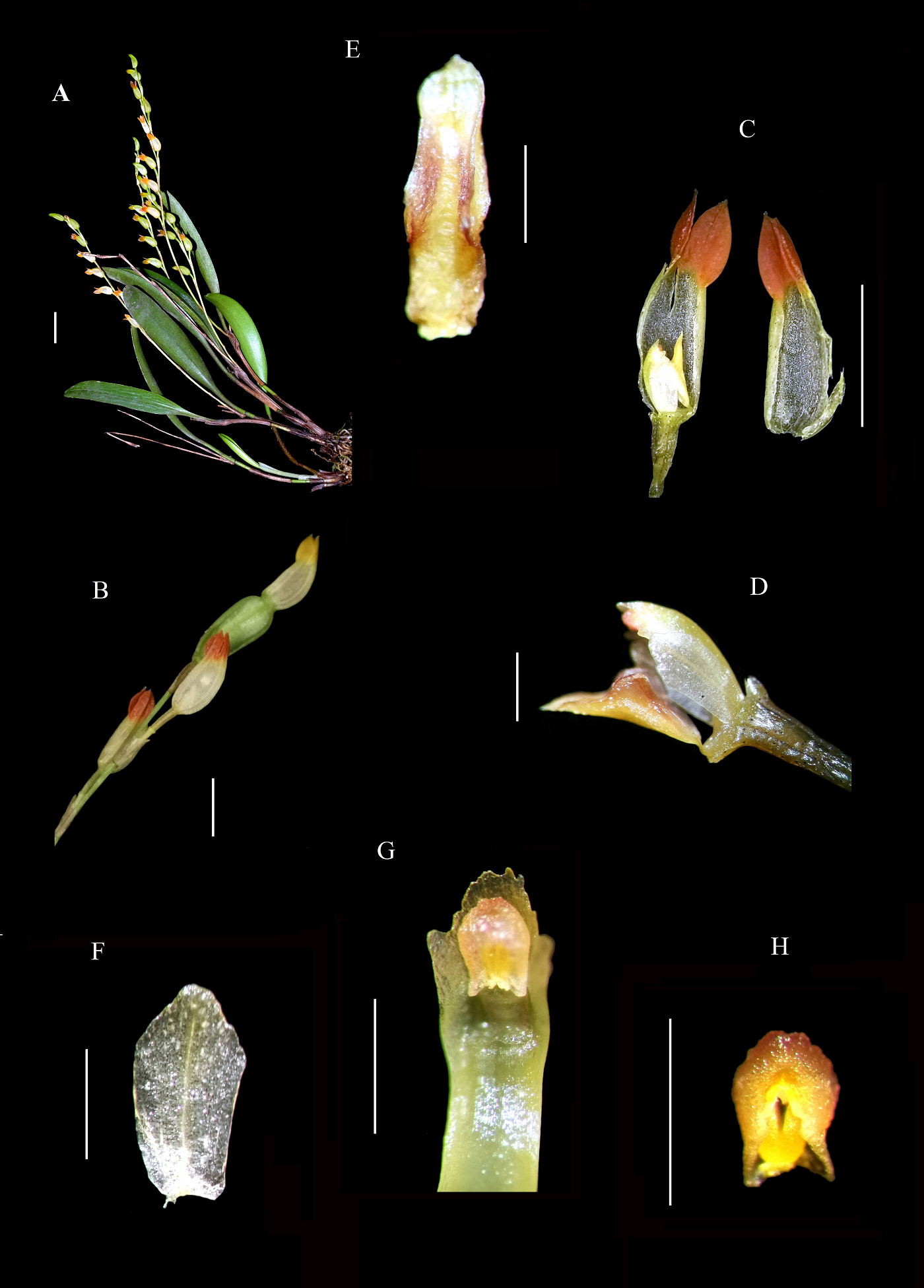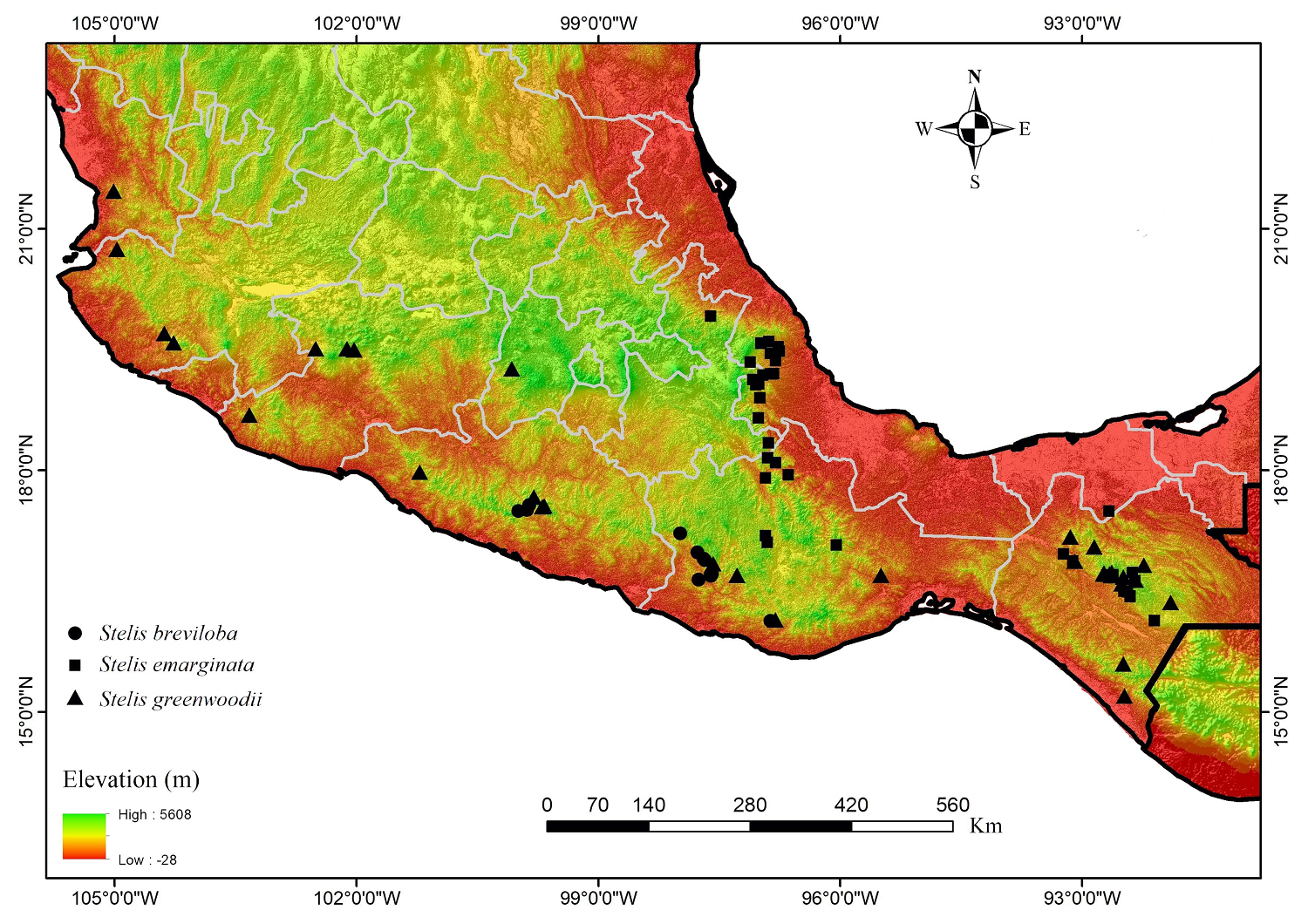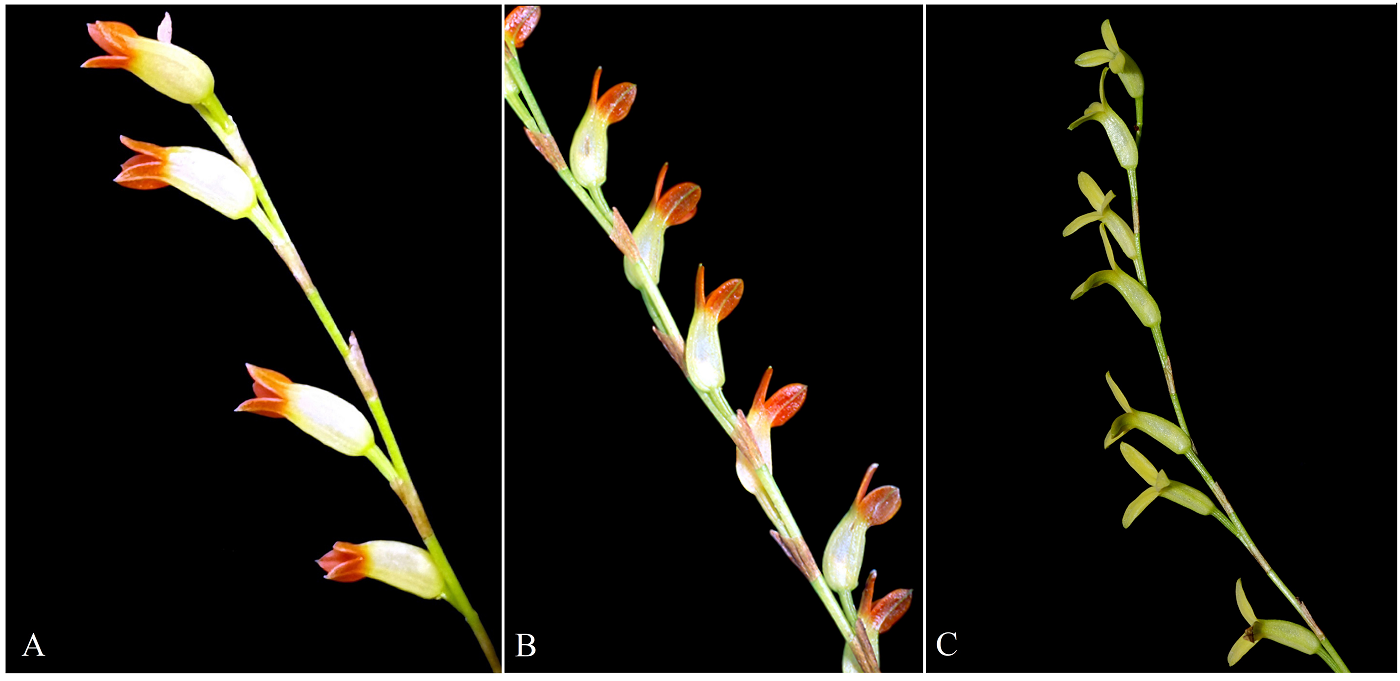The former genus Physosiphon Lindl. (Lindley 1835) was later included in the synonymy of either Pleurothallis R. Br. (Steudel 1841, Luer 1986) or Stelis Sw. (Pridgeon & Chase 2001, Pridgeon et al. 2005). Recent phylogenetic analyses based on DNA sequences of nuclear ribosomal ITS and plastid matK have confirmed that Physosiphon is part of Stelis s.l. (Karremans et al. 2013), and that it constitutes a well-supported monophyletic group within this genus. Therefore, the group was recently recognized as a subgenus of Stelis (Karremans 2019, Karremans & Vieira 2020), which is sister to a clade that includes S. subgen. Niphantha (Luer) Karremans, S. subgen. Physothallis (Garay) Karremans, S. subgen. Crocodeilanthe (Rchb. f. & Warsz.) Karremans and S. subgen. Stelis.
Species of Stelis subgen. Physosiphon (Lindl.) Karremans are distinguished by their stems formed by two internodes, with an annulus near the apex of the upper internode, a simultaneously flowered raceme, and secund flowers with a 3-lobed sepaline tube, inside which the rest of the floral structures are located, with a conduplicate, 3-lobed lip. According to Karremans (2019), this subgenus includes six species: Stelis asperrima (Luer) Pridgeon & M.W. Chase from Ecuador; S. emarginata (Lindl.) Soto Arenas & Solano from Puebla and Veracruz (Mexico) to Guatemala; S. greenwoodii Soto Arenas & Solano from Sinaloa and Durango (Mexico) to Nicaragua; S. mirandae Beutelsp. & Mor-Mol. from Chiapas (Mexico); S. punctulata (Rchb. f.) Soto Arenas from Chiapas (Mexico) to Colombia, Venezuela, and Ecuador; and S. tacanensis Solano & Soto Arenas from Chiapas (Mexico) and Guatemala. An additional species, Stelis pertusa I. Jiménez, recently described from Bolivia, has a raceme with tubular, pale-yellowish flowers that resemble members of subgen. Physosiphon, so it was considered as a member of this group (Jiménez-Pérez 2015). Hence, subgen. Physosiphon is essentially a Mesoamerican group with two South American outliers (Mesoamerica is considered here as the region including from the southern half of Mexico up to Costa Rica that is defined by cultural criteria (Pailes & Whitecotton 1995, Gast 2007), not as the geo-economically region defined by the Organization for Economic Cooperation and Development (OECD 2006)).
The best-known species in this group, the first one to have been described, the best documented in the literature, and the best known in cultivation, is Stelis emarginata.Solano & Soto-Arenas (2003) and Soto-Arenas & Solano (2003a, 2003b) clarified that S. emarginata corresponds to the reddish orange-flowered species from intermediate elevations along the mountain ranges facing the Gulf of Mexico, in Puebla, Veracruz, northern Oaxaca, northern Chiapas, and Guatemala. Recently, during botanical explorations conducted in southern Guerrero and Oaxaca, we found specimens of Stelis with tubular reddish orange flowers, as in S. emarginata, but far away from the known distribution area of the latter, on the Pacific slope of the Sierra Madre del Sur, where the only species of subgen. Physosiphon previously recorded was S. greenwoodii. When those specimens were analyzed and compared with similar species, it was determined that they represent an undescribed taxon, which is described and illustrated here as a new species. Information concerning its geographical distribution, habitat preferences, phenology, conservation status, and a list of specimens with documented presence in Mexico is provided, and the differences that permit distinguishing it from other Mesoamerican species of this subgenus are presented in a dichotomous key.
Materials and methods
The description of the new species was based on examination of live specimens in the greenhouse of Herbarium AMO, Mexico City and the personal collection of the junior author, as well as herbarium specimens housed in AMO, IEB, MEXU, and OAX (acronyms according to Thiers 2023). A line drawing was prepared from fresh material with a drawing tube adapted to a stereomicroscope (Wild Heerbrugg Type 308700). Additionally, an individual plant, an inflorescence, a flower, and its dissected floral parts were photographed with a Canon® EO S Rebel T2i digital camera and assembled in two color plates showing vegetative and floral traits, which were edited with Adobe Photoshop® CS4.
A morphological comparison of the new taxon with all the other Mesoamerican species of Stelis subgen. Physosiphon was done based on the specialized literature (Ames & Correll 1952, Hamer 1981, McVaugh 1985, Luer 1986, Béhar & Tinschert 1998, Solano & Soto-Arenas 2003, Soto-Arenas 2003, Soto-Arenas & Solano 2003a, 2003b, Soto-Arenas et al. 2007, Szeszko 2011, Archila et al. 2018, Beutelspacher & Moreno-Molina 2018, Viccón-Esquivel et al. 2021). The known localities of the new species and those of S. emarginata and S. greenwoodii were georeferenced and displayed on a map of Mexico using the software QGIS (QGIS 2023). Lastly, a key for the Mesoamerican species belonging to this subgenus was prepared.
Results
Stelis breviloba Solano & Salazar, sp. nov. (Figures 1-3).

Figure 1 Stelis breviloba. A) Portion of an inflorescence; B) flower and ovary in lateral view; C) Flower in longitudinal section showing petal, lip, and column; D) Floral dissection; E) Petal, lip, and column in lateral view; F) Petal, G) Column with anther; H) Lip in ventral view; I) Anther and pollinarium. Drawing by Rodolfo Solano from the type.

Figure 2 Stelis breviloba. A) Plant; B) Apical portion of the inflorescence with an immature capsule; C) A longitudinally sectioned flower showing petal, lip, and column within; D) Ovary with petals, lip, and column; E) Lip in ventral view; F) Petal in ventral view; G) column body in ventral view; H) Anther with pollinarium within. Scale bars represent 1 cm in A, 5 mm in B-C, 1 mm in D-H. Photographs: A, Gerardo A. Salazar, B-H by Rodolfo Solano, all from the type.

Figure 3 Plant of Stelis breviloba in its habitat, Santiago Nuyoo, Oaxaca. Photograph by Ubaldo Edgar García-López published in Naturalista.
Type. Mexico, Guerrero, municipio General Heliodoro Castillo, ca. 12 km de La Escalerilla hacia Filo de Caballos, 17º 29’ 47’’ N, 99º 59’ 32’’ W, 2,130 m, bosque mesofítico de barranca, flores amarillas con ápices naranja, 22 October 2006, G.A. Salazar, D.S. Gernandt, C. Granados Mendoza y D. Burguete 7365 (holotype: MEXU!).
Diagnosis. Similar to Stelis emarginata (Lindl.) Soto Arenas & Solano, from which it differs in its smaller habit (14 cm high vs. up to 25 cm), less floriferous raceme (7-11 flowers vs. up to 30), and shorter tubular flowers (5.2-7.0 mm vs.7.0-10.0 mm) with straight lobes of the lateral sepals (vs. almost plain to concave), and petals oblong (vs. obovate).
Description. Epiphytic or lithophytic, erect, cespitose herb up to 14 cm in tall including the inflorescence. Rhizome made up of 3 abbreviated internodes. Roots 0.5-0.6 mm in diameter, flexuous, whitish. Stems 1.5-3.8 cm long, 0.8-1.3 mm diameter, 1-leaved, terete, made up of 2 internodes, with and annulus 4.0-5.2 mm below the apex; fully covered by tubular, partially imbricating scarious sheaths, 1.0-2.5 cm long. Leaf 3.8-7.5 × 0.7-1.2 cm, elliptic or oblanceolate, rounded, emarginate and mucronate at the apex, coriaceous, attenuate toward the base into a channeled petiole 6.0-15.0 mm long. Inflorescence 1-2 per stem, racemose, up to 10.5 cm long, arising from the annulus, erect; rachis straight, with 7-11 simultaneous, suberect, secund flowers; peduncle 3.0-4.8 cm long, 0.5-0.6 mm diameter, terete, covered at its base by a spathaceous, conduplicate, scarious bract 4.0-5.5 mm long, plus 2-3 tubular, subacute, tight, membranaceous bracts 3.7-7.3 mm long. Floral bracts 4.0-7.5 mm long, obliquely funnel-shaped, obtuse, membranaceous. Flowers tubular, 5.2-7.0 mm long; sepaline tube whitish cream to greenish white with minute green dark dots, sepal lobes reddish orange with the mid-vein pale green to cream, petals and column greenish white, lip and anther reddish yellow, pollinia yellow. Sepals connate for 2/5 of their length into an ovoid-ellipsoid, trigonous, 3-lobed sepaline tube 4.0-4.5 mm long (without the lobes), 2.0-2.8 mm diameter; sepal lobes 2.9-3.2 × 1.8-2.0 mm (when spread out), straight, ovate, acute, apiculate, somewhat concave, fleshy, 3-veined, axially carinate. Petals 1.7-2.0 × 0.9-1.0 mm, cuneate-oblong, oblique, obtuse, 1-veined, with crystalline inclusions. Lip 2.5-2.6 × 0.9-1.3 mm when spread out, 3-lobed, oblong in outline, conduplicate at the middle, fleshy, 3-veined, abaxially 3-carinate; midlobe 0.8-1.1 × 0.8 mm, obovate, obtuse, papillose-lamellate; lateral lobes 0.4-0.6 mm long, erect, subquadrate, truncate, marginally bicarinate. Column 2.3-2.6 mm long, 0.8 mm wide, with a slender, semiterete, arching, apically winged body; column foot 0.9 mm long; clinandrium dentate, totally covering the anther. Stigmatic cavity ventral, orbicular-quadrate, viscous; rostellum ventral, laminar, quadrate. Anther 0.7 × 0.5 mm, ventral, ovoid to quadrangular-ovoid; pollinia two, 0.3-0.5 mm long, ovoid, yellow, with granulose caudicles. Ovary 1.5-2.5 mm long, 0.7-0.8 mm diameter, subterete; pedicel 2.3-2.8 mm long, 0.5 mm gross, terete. Capsule 8.0 mm long, 4.0 mm diameter, obovoid, trigonous, with persistent perianth.
Distribution and habitat. Stelis breviloba is known only from the Pacific slope of the Sierra Madre del Sur in the states of Guerrero and Oaxaca, Mexico (Figure 4), at 1,370-2,540 m elevation. The species grows as an epiphyte (Figure 3) in Pinus-Quercus forest and cloud forest, with Alnus sp., Ostrya sp., Pinus ayacahuite C. Ehrenb. ex Schtdl., P. oocarpa Schiede ex Schltdl., P. pringlei Shaw, P. tenuifolia Salisb., and Quercus spp. Sometimes the plant grows as a lithophyte in submontane scrub with Agave sp., Baccharis sp., Chiranthodendron pentadactylon Larreat., Clusia sp., Garrya sp., and Salvia sp.

Figure 4 Known distribution in Mexico for Stelis breviloba, S. emarginata and S. greenwoodii. Map by Raúl Rivera.
Conservation status. The conservation status of S. breviloba has not been evaluated formally, and additional field studies are required to ascertain it. None of the known localities of this species is located within a protected natural area, but its conservation depends on the protection of its habitat. Stelis breviloba grows in the Priority Terrestrial Regions of Sierra del Sur de Guerrero (Guerrero), Sierras Triqui-Mixteca (Oaxaca), and Sierra Sur y Costa de Oaxaca (Oaxaca), all of which hold a high biological diversity and concentrate an important amount of endemism of the Mexican flora (Arriaga et al. 2000, Aragón-Parada et al. 2021). Plants of this species have been seen offered for sale in Oaxacan local markets, probably collected incidentally when traders extract specimens of other orchid species with showier flowers from the forest. The traded specimens are used to decorate religious images at homes (Cruz-García et al. 2015).
Phenology. It flowers from May to December; ripen capsules have been seen in July.
Common names and uses. No common names are known for this species. Specimens have been seen for sale in local markets of the city of Tlaxiaco, Oaxaca, identified as S. emarginata, which are used as temporary adornments of religious figures (Cruz-García et al. 2015).
Etymology. The specific epithet, from Latin brevis, short, refers to the lobes of the sepaline tube, which are proportionally short in comparison with other members of Stelis subgen. Physosiphon.
Additional specimens examined. Mexico. Guerrero, Chilpancingo de los Bravo: Jaleaca de Catalán, El Tezcal, P. Almazán s.n. (MEXU!); Leonardo Bravo: 14 km al SW de Filo de Caballos [Puerto General Nicolás Bravo], 28 July 1979, O. Téllez & H. Hernandez 728 (MEXU!). Oaxaca, Santa Cruz Itundujia: La Barranca, 5 km al SW de Zaragoza, 1,377 m, 23 June 2007, K. Velasco-Gutiérrez et al. 2040 (MEXU!); Santa Cruz Itundujia: El Cajón, a 1.2 km en línea recta al SE de la agencia de Buena Vista, 2,024 m, 17 June 2008, K. Velasco-Gutiérrez et al. 2690 (IEB!); Santa Cruz Itundujia: Peñas Altas a 1.4 km al SW de agencia Buena Vista, 2,391 m, 31 July 2008, K. Velasco-Gutiérrez et al. 3027 (MEXU!); Santa Cruz Itundujia: La Torre, 2.8 km al E de La Independencia, 2,540 m, 05 August 2009, K. Velasco-Gutiérrez et al. 4155 (MEXU!); San Andrés Cabecera Nueva: El Espinal, 1,952 m, 13 December 2013, M. Cerrada-García & P. Salmoran 433 (MEXU!); San Jerónimo Coatlán: 33.2 km al SW de San Jerónimo Coatlán brecha a Piedra Larga, 1,550 m, 08 August 1990, A. Campos-Villanueva 3309 (MEXU!); Santiago Juxtlahuaca: camino a Putla, carr. San Agustín Atenango-Putla, 2,810 m [probably the correct elevation is 1,820 m], 19 June 1982, R. Torres & R. Cedillo 565 (MEXU!); Heroica Ciudad de Tlaxiaco: comercializado en el mercado de Tlaxiaco, 24 February 2012, G. Cruz-Garcia 27 (OAX!).
Other records. Mexico. Oaxaca: San Andrés Cabecera Nueva, 9 May 2021, D. Juárez (https://www.naturalista.mx/observations/105513335); Santiago Nuyoo, 24 August 2021, U.E. García-López (https://www.naturalista.mx/observations/92417851).
Key for Mesoamerican species of Stelis subgen. Physosiphon
1a. Leaves elliptic, abruptly attenuate at the base into a petiole, > 2.5 cm wide; sepaline lobes pubescent; plants from Ecuador to Bolivia……………………………………………………………………………………………………………………………………………… 2
1b. Leaves narrowly elliptic or oblong, gradually attenuate at the base into a petiole, < 2 cm wide; sepaline lobes glabrous; plants from Mexico to northern South America………………………………………………………………………………………… 3
2a. Inflorescence with a congested rachis, peduncle shorter than the leaf; plants from Bolivia……………… S. pertusa
2b. Inflorescence with a loose rachis, peduncle as long as the leaf; plants form Ecuador…………………… S. asperrima
3a. Inflorescence at least twice as long as the leaf; flowers fleshy, purplish, < 5 mm long……………… S. punctulata
3b. Inflorescence about as long as the leaf or less than twice the leaf length; flowers membranaceous, greenish, greenish yellow, yellowish, or reddish orange, > 5 mm long……………………………………………………………………….…………… 4
4a. Lobes of the sepaline tube greenish, greenish yellow or yellowish…………………………………………………………………… 5
4b. Lobes of the sepaline tube reddish orange ………………………………………………………………………………………………………… 7
5a. Leaves > 10 cm long; raceme > 30 cm long; peduncle longer than the leaf; flowers 14-22 mm long…………………………………………………………………………………………………………………………………………………………… S. tacanensis
5b. Leaves < 10 cm long; raceme < 25 cm long; peduncle equal to or shorter than the leaf; flowers < 14 mm long……………………………………………………………………………………………………………………………………………………………………………… 6
6a. Flowers 8-13 mm long; lobes of the sepaline tube recurved; petals obovate……………………………… S. greenwoodii
6b. Flowers 5-6 mm long; lobes of the sepaline tube straight; petals oblong……………………………………… S. mirandae
7a. Flowers 7-10 mm long, lobes of the sepaline tube recurved; petals obovate; plants from the Gulf slope in Puebla, Veracruz, northern Oaxaca, Chiapas, and Guatemala………………………………………………………… S. emarginata
7b. Flowers ( 7 mm long, lobes of the sepaline tube straight; petals oblong; plants from the Pacific slope in Guerrero and Oaxaca……………………………………………………………………………………………………………………………… S. breviloba
Discussion
Stelis breviloba is recognized by its peduncle as long as or slightly longer than the leaf, tubular flower up to mm long with pale green sepaline tube and reddish orange sepal lobes, obliquely oblong petals, and oblong, conduplicate lip (Figures 1-2, 5A). Stelis emarginata (Figure 5B) is the only other member of Stelis subgen. Physosiphon with pale green sepaline tube and reddish orange sepal lobes and may be confused with S. breviloba, but it differs from the latter in its larger plants (up to 25 cm high including the inflorescence vs. up to 14 cm high), more floriferous raceme (up to 30 flowers vs. 7-11), larger flowers (7.0-10.0 mm long vs. 5.2-7.0 mm), recurved and convex sepal lobes (vs. straight and almost plain to concave), and shorter petals (1.5-1.7 mm long vs. 1.7-2.0 mm long). In addition, the distribution of both species is allopatric (Figure 4): S. emarginata is distributed along Gulf of Mexico slope of the Sierra Madre Oriental in Veracruz, northern mountains of Oaxaca, and northern portion The Transisthmic Highlands (Central Plateau) of Chiapas (Soto-Arenas & Solano, 2003a), whereas S. breviloba is found on the Pacific slope of the Sierra Madre del Sur in Guerrero and Oaxaca.

Figure 5 Portions of inflorescences of A) Stelis breviloba, photograph by Gerardo A. Salazar from Salazar et al. 7365 (MEXU), B) S. emarginata, photograph by Rodolfo Solano from Sánchez 300 (AMO), and C) S. greenwoodii, photograph by Gerardo A. Salazar from Salazar 7465 (MEXU).
Another similar species is Stelis greenwoodii (Figure 5C), which is partially sympatric with S. breviloba. However, the former is distinguished by its robust habit (up to 30 cm tall including the inflorescence vs. up to 14 cm), more floriferous raceme (14-32 flowers vs. 7-11), larger flowers (8.5-12.5 mm vs. 5.2-7.0 mm), lemon-yellow to dark-yellow, recurved sepal lobes (vs. reddish orange, straight and almost plain to concave). Additionally, S. greenwoodii prefers drier Quercus forest in comparison with S. breviloba, which prefers wet Pinus-Quercus forest and cloud forest.
Ecuadorian Stelis asperrima is very similar to the recently described, Bolivian S. pertusa; although both have tubular flowers that resemble those of other species of S. subgen. Physosiphon, in habit (large plants, stem as long as the leaf, elliptic and broadened leaves) both species are more similar to S. subgen. Dracontia (Luer) Karremans, so they might represent members of the latter subgenus that independently acquired the tubular flowers, but this hypothesis will have to be tested when the concerned species are included in molecular phylogenetic analyses with an appropriate sample of representatives of the various subgenera of Stelis. Should the Ecuadorian and Bolivian species prove to be members of S. subgen. Dracontia, Stelis subgen. Physosiphon would be an essentially Mesoamerican group with all its species being part of the Mexican flora.











 text new page (beta)
text new page (beta)



